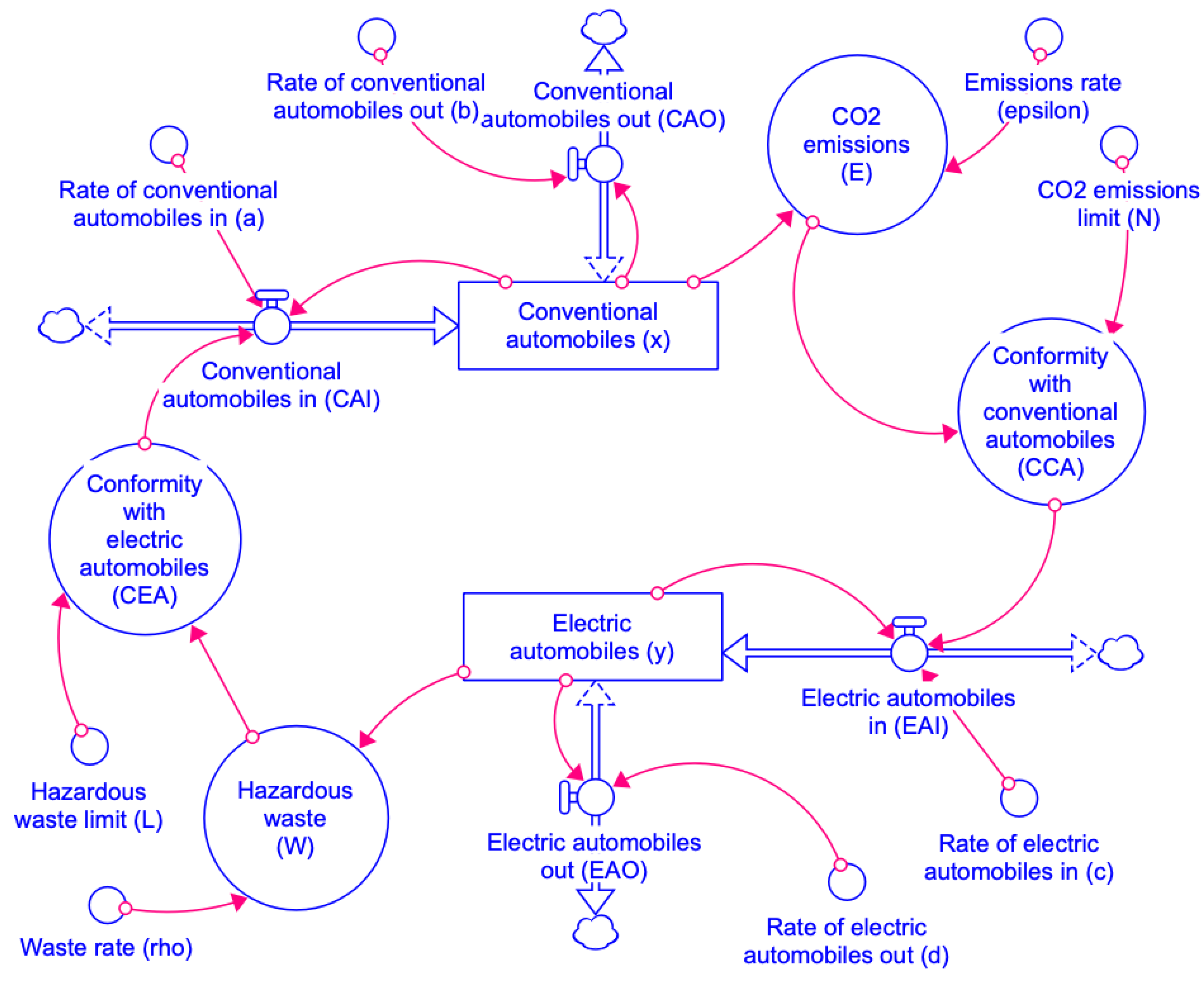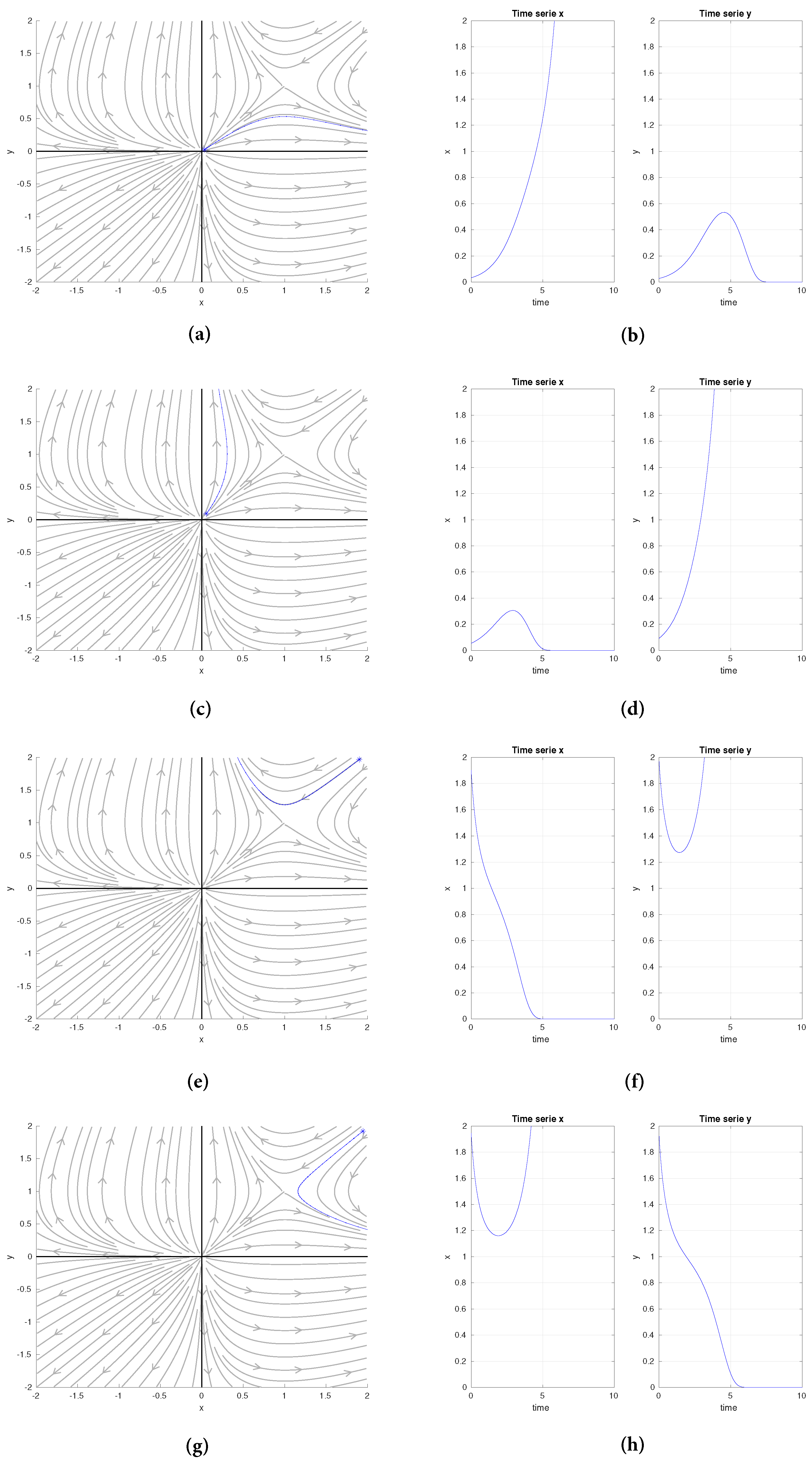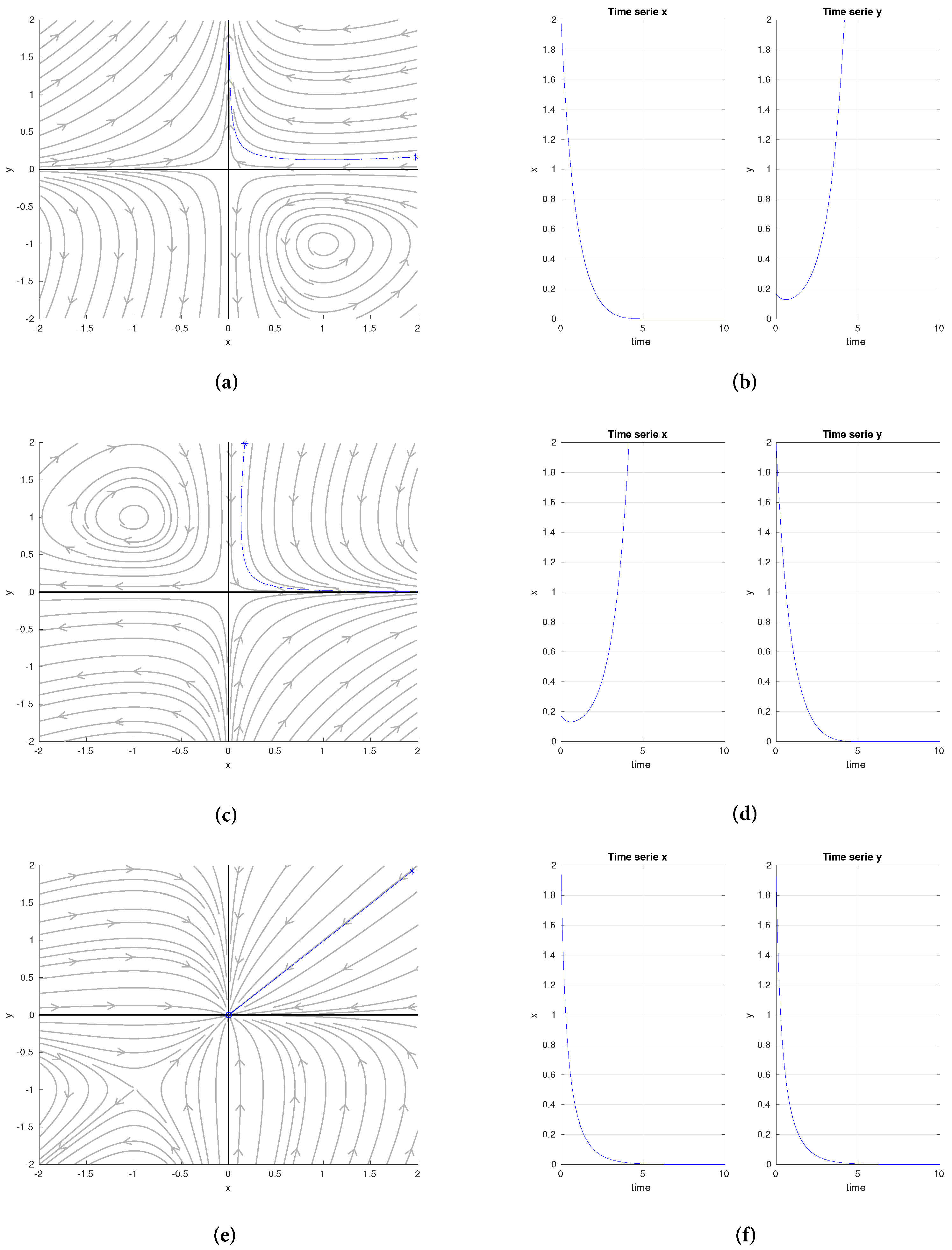Automobile Technological Transition Scenarios Based on Environmental Drivers
Abstract
:1. Introduction
2. Materials and Methods
- The system state does not change spontaneously
- The evolution law of the system does not change in time
3. Results
Two-Dimensional Bifurcation Analysis
4. Discussion
4.1. Family Transition 1
4.2. Family Transition 2
4.3. Family Transition 3
4.4. Family Transition 4
4.5. Future Research
5. Conclusions
Author Contributions
Funding
Institutional Review Board Statement
Informed Consent Statement
Data Availability Statement
Acknowledgments
Conflicts of Interest
References
- Rhodes, C.J. The 2015 Paris Climate Change Conference: COP21. Sci. Prog. 2016, 99, 97–104. [Google Scholar] [CrossRef]
- Guan, D.; Meng, J.; Reiner, D.M.; Zhang, N.; Shan, Y.; Mi, Z.; Shao, S.; Liu, Z.; Zhang, Q.; Davis, S.J. Structural decline in China’s CO2 emissions through transitions in industry and energy systems. Nat. Geosci. 2018, 11, 551–555. [Google Scholar] [CrossRef]
- Zeng, S.; Li, G.; Wu, S.; Dong, Z. The Impact of Green Technology Innovation on Carbon Emissions in the Context of Carbon Neutrality in China: Evidence from Spatial Spillover and Nonlinear Effect Analysis. Int. J. Environ. Res. Public Health 2022, 19, 730. [Google Scholar] [CrossRef]
- Goodwin, P.; Katavouta, A.; Roussenov, V.M.; Foster, G.L.; Rohling, E.J.; Williams, R.G. Pathways to 1.5 C and 2 C warming based on observational and geological constraints. Nat. Geosci. 2018, 11, 102–107. [Google Scholar] [CrossRef]
- The Intergovernmental Panel on Climate Change. Mitigation of climate change. In Contribution of Working Group III to the Fifth Assessment Report of the Intergovernmental Panel on Climate Change; Cambridge University Press: Cambridge, UK, 2014; Volume 1454, p. 147. [Google Scholar]
- Winkler, H.; Boyd, A.; Torres Gunfaus, M.; Raubenheimer, S. Reconsidering development by reflecting on climate change. Int. Environ. Agreem. Politics Law Econ. 2015, 15, 369–385. [Google Scholar] [CrossRef]
- Agency, I.E. Global Energy Review 2021; International Energy Agency: Paris, France, 2021. [Google Scholar]
- Agency, I.E. World Energy Outlook 2020; International Energy Agency: Paris, France, 2020. [Google Scholar]
- Gil-García, I.C.; García-Cascales, M.S.; Dagher, H.; Molina-García, A. Electric vehicle and renewable energy sources: Motor fusion in the energy transition from a multi-indicator perspective. Sustainability 2021, 13, 3430. [Google Scholar] [CrossRef]
- Agency, I.E. Global EV Outlook 2020; International Energy Agency: Paris, France, 2020. [Google Scholar]
- Masson-Delmotte, V.; Zhai, P.; Pirani, A.; Connors, S.; Péan, C.; Berger, S.; Caud, N.; Chen, Y.; Goldfarb, L.; Gomis, M.; et al. Climate Change 2021: The Physical Science Basis. In Contribution of Working Group I to the Sixth Assessment Report of the Intergovernmental Panel on Climate Change; Cambridge University Press: Cambridge, UK, 2021. [Google Scholar]
- Nimesh, V.; Kumari, R.; Soni, N.; Goswami, A.K.; Mahendra Reddy, V. Implication viability assessment of electric vehicles for different regions: An approach of life cycle assessment considering exergy analysis and battery degradation. Energy Convers. Manag. 2021, 237, 114104. [Google Scholar] [CrossRef]
- Zeng, D.; Dong, Y.; Cao, H.; Li, Y.; Wang, J.; Li, Z.; Hauschild, M.Z. Are the electric vehicles more sustainable than the conventional ones? Influences of the assumptions and modeling approaches in the case of typical cars in China. Resour. Conserv. Recycl. 2021, 167, 105210. [Google Scholar] [CrossRef]
- Sengupta, S.; Cohan, D.S. Fuel cycle emissions and life cycle costs of alternative fuel vehicle policy options for the City of Houston municipal fleet. Transp. Res. Part Transp. Environ. 2017, 54, 160–171. [Google Scholar] [CrossRef] [Green Version]
- Bauer, G. The impact of battery electric vehicles on vehicle purchase and driving behavior in Norway. Transp. Res. Part Transp. Environ. 2018, 58, 239–258. [Google Scholar] [CrossRef]
- Bakker, S.; Dematera Contreras, K.; Kappiantari, M.; Tuan, N.A.; Guillen, M.D.; Gunthawong, G.; Zuidgeest, M.; Liefferink, D.; Van Maarseveen, M. Low-carbon transport policy in four ASEAN countries: Developments in Indonesia, the Philippines, Thailand and Vietnam. Sustainability 2017, 9, 1217. [Google Scholar] [CrossRef] [Green Version]
- Bergman, N.; Schwanen, T.; Sovacool, B.K. Imagined people, behaviour and future mobility: Insights from visions of electric vehicles and car clubs in the United Kingdom. Transp. Policy 2017, 59, 165–173. [Google Scholar] [CrossRef]
- Sovacool, B.K.; Kester, J.; Noel, L.; de Rubens, G.Z. Are electric vehicles masculinized? Gender, identity, and environmental values in Nordic transport practices and vehicle-to-grid (V2G) preferences. Transp. Res. Part Transp. Environ. 2019, 72, 187–202. [Google Scholar] [CrossRef]
- Agency, I.E. Electric Cars Fend off Supply Challenges to more than Double Global Sales; International Energy Agency: Paris, France, 2022. [Google Scholar]
- Ke, W.; Zhang, S.; He, X.; Wu, Y.; Hao, J. Well-to-wheels energy consumption and emissions of electric vehicles: Mid-term implications from real-world features and air pollution control progress. Appl. Energy 2017, 188, 367–377. [Google Scholar] [CrossRef]
- Gopal, A.R.; Park, W.Y.; Witt, M.; Phadke, A. Hybrid- and battery-electric vehicles offer low-cost climate benefits in China. Transp. Res. Part Transp. Environ. 2018, 62, 362–371. [Google Scholar] [CrossRef]
- Duan, H.; Hu, M.; Zuo, J.; Zhu, J.; Mao, R.; Huang, Q. Assessing the carbon footprint of the transport sector in mega cities via streamlined life cycle assessment: A case study of Shenzhen, South China. Int. J. Life Cycle Assess. 2017, 22, 683–693. [Google Scholar] [CrossRef]
- Liao, F.; Molin, E.; van Wee, B. Consumer preferences for electric vehicles: A literature review. Transp. Rev. 2017, 37, 252–275. [Google Scholar] [CrossRef] [Green Version]
- Simsek, Y.; Sahin, H.; Lorca, Á.; Santika, W.G.; Urmee, T.; Escobar, R. Comparison of energy scenario alternatives for Chile: Towards low-carbon energy transition by 2030. Energy 2020, 206, 118021. [Google Scholar] [CrossRef]
- Bauer, C.; Hofer, J.; Althaus, H.J.; Del Duce, A.; Simons, A. The environmental performance of current and future passenger vehicles: Life cycle assessment based on a novel scenario analysis framework. Appl. Energy 2015, 157, 871–883. [Google Scholar] [CrossRef]
- Onn, C.C.; Mohd, N.S.; Yuen, C.W.; Loo, S.C.; Koting, S.; Abd Rashid, A.F.; Karim, M.R.; Yusoff, S. Greenhouse gas emissions associated with electric vehicle charging: The impact of electricity generation mix in a developing country. Transp. Res. Part Transp. Environ. 2018, 64, 15–22. [Google Scholar] [CrossRef]
- Rahman, I.; Vasant, P.M.; Singh, B.S.M.; Abdullah-Al-Wadud, M.; Adnan, N. Review of recent trends in optimization techniques for plug-in hybrid, and electric vehicle charging infrastructures. Renew. Sustain. Energy Rev. 2016, 58, 1039–1047. [Google Scholar] [CrossRef]
- Singh, R.; Kumar, A.; Singh, A.R.; Naidoo, R.; Bansal, R.C.; Kumar, P. Environmental feasibility of incorporation of electric taxis in South Africa. J. Eng. 2019, 2019, 5078–5084. [Google Scholar] [CrossRef]
- Taljegard, M.; Göransson, L.; Odenberger, M.; Johnsson, F. Impacts of electric vehicles on the electricity generation portfolio–A Scandinavian-German case study. Appl. Energy 2019, 235, 1637–1650. [Google Scholar] [CrossRef]
- Doucette, R.T.; McCulloch, M.D. Modeling the prospects of plug-in hybrid electric vehicles to reduce CO2 emissions. Appl. Energy 2011, 88, 2315–2323. [Google Scholar] [CrossRef]
- Jochem, P.; Babrowski, S.; Fichtner, W. Assessing CO2 emissions of electric vehicles in Germany in 2030. Transp. Res. Part Policy Pract. 2015, 78, 68–83. [Google Scholar] [CrossRef] [Green Version]
- Asghari, M.; MirzapourAl-e hashem, S.M.J. New Advances in Vehicle Routing Problems: A Literature Review to Explore the Future. In Green Transportation and New Advances in Vehicle Routing Problems; Springer Nature: Berlin, Germany, 2020; pp. 1–42. [Google Scholar] [CrossRef]
- Hao, H.; Cheng, X.; Liu, Z.; Zhao, F. Electric vehicles for greenhouse gas reduction in China: A cost-effectiveness analysis. Transp. Res. Part Transp. Environ. 2017, 56, 68–84. [Google Scholar] [CrossRef]
- Liu, X.; Sun, X.; Zheng, H.; Huang, D. Do policy incentives drive electric vehicle adoption? Evidence from China. Transp. Res. Part Policy Pract. 2021, 150, 49–62. [Google Scholar] [CrossRef]
- Fishman, T.; Myers, R.J.; Rios, O.; Graedel, T. Implications of emerging vehicle technologies on rare earth supply and demand in the United States. Resources 2018, 7, 9. [Google Scholar] [CrossRef] [Green Version]
- Greim, P.; Solomon, A.; Breyer, C. Assessment of lithium criticality in the global energy transition and addressing policy gaps in transportation. Nat. Commun. 2020, 11, 4570. [Google Scholar] [CrossRef]
- Christensen, P.A.; Anderson, P.A.; Harper, G.D.; Lambert, S.M.; Mrozik, W.; Rajaeifar, M.A.; Wise, M.S.; Heidrich, O. Risk management over the life cycle of lithium-ion batteries in electric vehicles. Renew. Sustain. Energy Rev. 2021, 148, 111240. [Google Scholar] [CrossRef]
- Kieckhäfer, K.; Wachter, K.; Spengler, T.S. Analyzing manufacturers’ impact on green products’ market diffusion—The case of electric vehicles. J. Clean. Prod. 2017, 162, S11–S25. [Google Scholar] [CrossRef]
- Onat, N.C.; Kucukvar, M.; Tatari, O.; Egilmez, G. Integration of system dynamics approach toward deepening and broadening the life cycle sustainability assessment framework: A case for electric vehicles. Int. J. Life Cycle Assess. 2016, 21, 1009–1034. [Google Scholar] [CrossRef]
- Oshiro, K.; Masui, T. Diffusion of low emission vehicles and their impact on CO2 emission reduction in Japan. Energy Policy 2015, 81, 215–225. [Google Scholar] [CrossRef]
- Zhou, X.; Kuosmanen, T. What drives decarbonization of new passenger cars? Eur. J. Oper. Res. 2020, 284, 1043–1057. [Google Scholar] [CrossRef]
- Zeng, S.; Nan, X.; Liu, C.; Chen, J. The response of the Beijing carbon emissions allowance price (BJC) to macroeconomic and energy price indices. Energy Policy 2017, 106, 111–121. [Google Scholar] [CrossRef]
- Zeng, S.; Jia, J.; Su, B.; Jiang, C.; Zeng, G. The volatility spillover effect of the European Union (EU) carbon financial market. J. Clean. Prod. 2021, 282, 124394. [Google Scholar] [CrossRef]
- Shafiei, E.; Davidsdottir, B.; Leaver, J.; Stefansson, H.; Asgeirsson, E.I. Comparative analysis of hydrogen, biofuels and electricity transitional pathways to sustainable transport in a renewable-based energy system. Energy 2015, 83, 614–627. [Google Scholar] [CrossRef]
- Jochem, P.; Gómez Vilchez, J.J.; Ensslen, A.; Schäuble, J.; Fichtner, W. Methods for forecasting the market penetration of electric drivetrains in the passenger car market. Transp. Rev. 2018, 38, 322–348. [Google Scholar] [CrossRef] [Green Version]
- García-Olivares, A.; Solé, J.; Osychenko, O. Transportation in a 100% renewable energy system. Energy Convers. Manag. 2018, 158, 266–285. [Google Scholar]
- Coffman, M.; Bernstein, P.; Wee, S. Electric vehicles revisited: A review of factors that affect adoption. Transp. Rev. 2017, 37, 79–93. [Google Scholar] [CrossRef]
- Paiho, S.; Saastamoinen, H.; Hakkarainen, E.; Similä, L.; Pasonen, R.; Ikäheimo, J.; Rämä, M.; Tuovinen, M.; Horsmanheimo, S. Increasing flexibility of Finnish energy systems—A review of potential technologies and means. Sustain. Cities Soc. 2018, 43, 509–523. [Google Scholar] [CrossRef]
- Mersky, A.C.; Sprei, F.; Samaras, C.; Qian, Z.S. Effectiveness of incentives on electric vehicle adoption in Norway. Transp. Res. Part Transp. Environ. 2016, 46, 56–68. [Google Scholar] [CrossRef] [Green Version]
- Bjerkan, K.Y.; Nørbech, T.E.; Nordtømme, M.E. Incentives for promoting battery electric vehicle (BEV) adoption in Norway. Transp. Res. Part Transp. Environ. 2016, 43, 169–180. [Google Scholar] [CrossRef] [Green Version]
- Kester, J.; Noel, L.; de Rubens, G.Z.; Sovacool, B.K. Promoting Vehicle to Grid (V2G) in the Nordic region: Expert advice on policy mechanisms for accelerated diffusion. Energy Policy 2018, 116, 422–432. [Google Scholar] [CrossRef]
- Lin, X.; Sovacool, B.K. Inter-niche competition on ice? Socio-technical drivers, benefits and barriers of the electric vehicle transition in Iceland. Environ. Innov. Soc. Transit. 2020, 35, 1–20. [Google Scholar] [CrossRef]
- Dhar, S.; Pathak, M.; Shukla, P.R. Electric vehicles and India’s low carbon passenger transport: A long-term co-benefits assessment. J. Clean. Prod. 2017, 146, 139–148. [Google Scholar] [CrossRef] [Green Version]
- Morcillo, J.D.; Franco, C.J.; Angulo, F. Simulation of demand growth scenarios in the Colombian electricity market: An integration of system dynamics and dynamic systems. Appl. Energy 2018, 216, 504–520. [Google Scholar] [CrossRef]
- Morcillo, J.D.; Angulo, F.; Franco, C.J. Simulation and Analysis of Renewable and Nonrenewable Capacity Scenarios under Hybrid Modeling: A Case Study. Mathematics 2021, 9, 1560. [Google Scholar] [CrossRef]
- Sterman, J. Business Dynamics; McGraw-Hill, Inc.: New York, NY, USA, 2000. [Google Scholar]
- Bektaş, T.; Laporte, G. The pollution-routing problem. Transp. Res. Part Methodol. 2011, 45, 1232–1250. [Google Scholar] [CrossRef]
- Watari, T.; Nansai, K.; Nakajima, K.; McLellan, B.C.; Dominish, E.; Giurco, D. Integrating circular economy strategies with low-carbon scenarios: Lithium use in electric vehicles. Environ. Sci. Technol. 2019, 53, 11657–11665. [Google Scholar] [CrossRef]
- Barlas, Y. Formal aspects of model validity and validation in system dynamics. Syst. Dyn. Rev. J. Syst. Dyn. Soc. 1996, 12, 183–210. [Google Scholar] [CrossRef]
- Kuznetsov, Y.A. Elements of Applied Bifurcation Theory; Springer: Berlin/Heidelberg, Germany, 2013; Volume 112. [Google Scholar]
- Wiggins, S.; Wiggins, S.; Golubitsky, M. Introduction to Applied Nonlinear Dynamical Systems and Chaos; Springer: Berlin/Heidelberg, Germany, 2003; Volume 2. [Google Scholar]
- Dong, X.; Zhang, B.; Wang, B.; Wang, Z. Urban households’ purchase intentions for pure electric vehicles under subsidy contexts in China: Do cost factors matter? Transp. Res. Part Policy Pract. 2020, 135, 183–197. [Google Scholar] [CrossRef]
- Graabak, I.; Wu, Q.; Warland, L.; Liu, Z. Optimal planning of the Nordic transmission system with 100% electric vehicle penetration of passenger cars by 2050. Energy 2016, 107, 648–660. [Google Scholar] [CrossRef]
- Bhuvandas, D.; Gundimeda, H. Welfare impacts of transport fuel price changes on Indian households: An application of LA-AIDS model. Energy Policy 2020, 144, 111583. [Google Scholar] [CrossRef]
- Kanger, L.; Geels, F.W.; Sovacool, B.; Schot, J. Technological diffusion as a process of societal embedding: Lessons from historical automobile transitions for future electric mobility. Transp. Res. Part Transp. Environ. 2019, 71, 47–66. [Google Scholar] [CrossRef]
- Redondo, J.M.; Olivar, G.; Ibarra-Vega, D.; Dyner, I. Modeling for the regional integration of electricity markets. Energy Sustain. Dev. 2018, 43, 100–113. [Google Scholar] [CrossRef]




Publisher’s Note: MDPI stays neutral with regard to jurisdictional claims in published maps and institutional affiliations. |
© 2022 by the authors. Licensee MDPI, Basel, Switzerland. This article is an open access article distributed under the terms and conditions of the Creative Commons Attribution (CC BY) license (https://creativecommons.org/licenses/by/4.0/).
Share and Cite
García, J.S.; Morcillo, J.D.; Redondo, J.M.; Becerra-Fernandez, M. Automobile Technological Transition Scenarios Based on Environmental Drivers. Appl. Sci. 2022, 12, 4593. https://doi.org/10.3390/app12094593
García JS, Morcillo JD, Redondo JM, Becerra-Fernandez M. Automobile Technological Transition Scenarios Based on Environmental Drivers. Applied Sciences. 2022; 12(9):4593. https://doi.org/10.3390/app12094593
Chicago/Turabian StyleGarcía, Julieth Stefany, José D. Morcillo, Johan Manuel Redondo, and Mauricio Becerra-Fernandez. 2022. "Automobile Technological Transition Scenarios Based on Environmental Drivers" Applied Sciences 12, no. 9: 4593. https://doi.org/10.3390/app12094593
APA StyleGarcía, J. S., Morcillo, J. D., Redondo, J. M., & Becerra-Fernandez, M. (2022). Automobile Technological Transition Scenarios Based on Environmental Drivers. Applied Sciences, 12(9), 4593. https://doi.org/10.3390/app12094593






